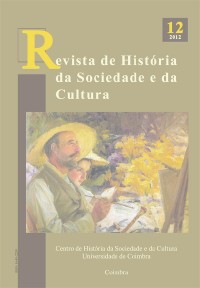Please use this identifier to cite or link to this item:
https://hdl.handle.net/10316.2/39422| DC Field | Value | Language |
|---|---|---|
| dc.contributor.author | Leitão, Francisco | - |
| dc.date.accessioned | 2016-09-10T09:28:37Z | |
| dc.date.accessioned | 2020-09-29T20:23:38Z | - |
| dc.date.available | 2016-09-10T09:28:37Z | |
| dc.date.available | 2020-09-29T20:23:38Z | - |
| dc.date.issued | 2012 | - |
| dc.identifier.issn | 1645-2259 | - |
| dc.identifier.issn | 2183-8615 (digital) | - |
| dc.identifier.uri | https://hdl.handle.net/10316.2/39422 | - |
| dc.description.abstract | Os vestígios arqueológicos deixados pelos Visigodos em forma de cemitérios podem ser importantes fontes para a compreensão da sociedade que viveu durante a Alta Idade Média na Península Ibérica. O principal objectivo deste trabalho é compreender que tipo de conclusões, se algumas, podem ser inferidas através deste tipo de fonte. Uma primeira ideia propondo que o espaço destinado aos mortos reflecte a sociedade dos vivos não seria nova e uma segunda, defendendo a próxima relação entre os dois, ainda que menos óbvia continuaria a ser relativamente consensual. Originando da necessidade prática de lidar com os corpos dos elementos defuntos, as sociedades humanas tiveram e têm que encontrar respostas e procedimentos que irão, inevitavelmente, reflectir as suas ansiedades, crenças e esperanças. A Alta Idade Média Peninsular não poderia ser diferente. Não é claro, contudo, se é possível compreender tais atitudes culturais meramente a partir das pequenas informações disponíveis pois este foi um período de grande instabilidade e de profundas contradições, onde diferentes povos e culturas experimentaram um complexo processo de contacto e influencia mútuos. Sabemos de antemão que, devido a tal heterogeneidade e ao limitado número de fontes disponíveis, não será possível alcançar sólidas conclusões acerca das mentalidades do tempo. Este trabalho, contudo, tentará perceber se, a partir destes vestígios arqueológicos, algumas ideias podem ser desenvolvidas sobre a Identidade e o Poder na sociedade em questão. | por |
| dc.description.abstract | The archeological evidence left by the Visigothic cemeteries can prove to be a significant piece of information for a better analysis of the society that lived in Early Medieval Hispania. The main purpose of this essay is precisely to understand what kind of conclusions, if any, can be extracted from them. A first idea stating that the places of the dead reflect the society of the living is not a new one but a second, sustaining that the habitats of the living and the places of the dead were always in a close relation might be less obvious even if fairly consensual. Springing from a very practical need of dealing with the dead bodies, human societies had and have to find answers and procedures which will, inevitably, reflect their anxieties, beliefs and hopes. Early Medieval Hispania could not be any different. However, it is unclear if we can understand those cultural attitudes from the little evidence at our disposition for this was a period of great instability and striking contradictions, where different peoples and cultures were in a complex process of mutual contact and influence. One knows from the start that, due to this great complexity and to the scarcity of sources available, it will not be possible to reach solid conclusions about the mentalities of the time. This essay, however, will attempt to understand if, from the archeological evidence left by the cemeteries, ideas can be developed about Identity and Power in the Visigothic society | eng |
| dc.language.iso | eng | - |
| dc.publisher | Centro de História da Sociedade e da Cultura | - |
| dc.rights | open access | - |
| dc.subject | Early Midde Ages | eng |
| dc.subject | Visigoths | eng |
| dc.subject | Cemeteries | eng |
| dc.subject | Ethnicity | eng |
| dc.subject | Identity | eng |
| dc.subject | Alta Idade Média | por |
| dc.subject | Visigodos | por |
| dc.subject | Cemitérios | por |
| dc.subject | Etnias | por |
| dc.subject | Identidade | por |
| dc.title | The Visigothic society and its cemeteries | por |
| dc.type | article | - |
| uc.publication.collection | Revista de História da Sociedade e da Cultura vol. 12 | - |
| uc.publication.firstPage | 9 | - |
| uc.publication.lastPage | 23 | - |
| uc.publication.location | Coimbra | - |
| uc.publication.journalTitle | Revista de História da Sociedade e da Cultura | - |
| uc.publication.volume | 12 | por |
| dc.identifier.doi | 10.14195/1645-2259_12_1 | - |
| uc.publication.section | Artigos | - |
| uc.publication.orderno | 2 | - |
| uc.publication.area | Artes e Humanidades | - |
| uc.publication.manifest | https://dl.uc.pt/json/iiif/10316.2/39422/247707/manifest?manifest=/json/iiif/10316.2/39422/247707/manifest | - |
| uc.publication.thumbnail | https://dl.uc.pt/retrieve/11850421 | - |
| item.grantfulltext | open | - |
| item.fulltext | With Fulltext | - |
| Appears in Collections: | Revista de História da Sociedade e da Cultura | |
Files in This Item:
| File | Description | Size | Format | |
|---|---|---|---|---|
| the_visigothic_society_and_its_cemeteries.pdf | 578.44 kB | Adobe PDF |  |
Items in DSpace are protected by copyright, with all rights reserved, unless otherwise indicated.
